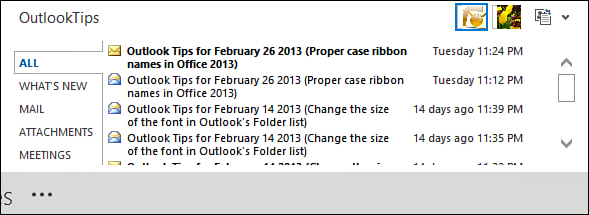10. Social Connector
In This Chapter
• Meeting the Social Connector
• Using the People pane
• Understanding Social Connector Security
Outlook’s Social Connector does a little of everything. It displays a person’s recent activities, including email, appointments, and attachments, in a pane at the bottom of an email message or contact. If you have a Facebook or LinkedIn account and have Outlook signed into the accounts, you’ll also see updates the person posts to these social networks.
Meet the Social Connector
When you first open Outlook, the Social Connector is empty, displaying only email to or from the sender or recipients of the selected email messages. If you look at a contact, the Social Connector shows messages sent or received by the contact or meetings with the contact. Activity feeds and profile photos from networking sites, such as Facebook, LinkedIn, or SharePoint Server, are displayed in the Social Connector’s pane after you configure Outlook to connect to the social networking service.
Configuring the Social Connector
Out of the box, the Social Connector’s People pane acts like a search folder—messages and meetings between you and the sender are displayed in the People pane (see Figure 10.1). Selecting a message in the list opens the message.

FIGURE 10.1 The People pane displays at the bottom of the Reading pane and contacts. Click the contact photos to view email and other activities between you and that person.
When a message is sent to more than one person, each person is listed in the People pane, and selecting any of the pictures or the icon representing the person displays your activities with that person: messages to or from that person, their social networking feeds (based on their social network security settings), appointments, or attachments to or from them.
If you don’t want to see the People pane, you can turn it off or minimize it. See Showing or Hiding the Social Connector Pane, later in this chapter.
 Tip
Tip
You can use the People pane without connecting to social networks. The People pane displays Outlook items—email, meetings, and email attachments—and the sender or recipient’s photo when a photo is added to that contact.
To view updates from social networks in the pane, you need to configure the social providers in Outlook. Outlook 2013 includes Facebook, LinkedIn, and SharePoint providers with the default installation, and you can go online to download additional connectors (when available).
 Note
Note
To see a person’s Facebook profile picture or activity feed, the person needs to have a public profile picture and have an email address configured in his or her Facebook account.
Setting Up Social Networking Accounts
Before you can view profile photos and status updates for people who send you email, you need to connect Outlook to the social network. Follow these steps:
1. Switch to the View tab.
2. Expand the People pane button.
3. Select Account Settings from the menu.
4. Click to select a social network you want to use.
5. Enter your name and password (see Figure 10.2).

FIGURE 10.2 Sign in to the social networks. Outlook 2013 includes Social Connector providers for Facebook, LinkedIn, and SharePoint server.
6. Click Connect to link the social network to Outlook.
7. If you want the social network to be the default source for contact photos, select By Default, Show Photos and Information from This Network When Available.
Select the next social network and repeat the process.
 Tip
Tip
If you are unable to connect Outlook to Facebook and you receive an “invalid username or password” message, check your security settings at Facebook. You need to give Outlook permission to access Facebook.
If you want to remove a social network, select the network and click the X on the right to delete your username and password for the social network (see Figure 10.3).

FIGURE 10.3 To sign out of the social network, click the X. To change your account, click the white Paper icon.
If you change your username or password on the social network, you’ll need to change it in the Social Connector. Click the Paper icon to change your username and password. Click the Options button to view or change the settings Office applies to data shared between Office and the social network, which is contacts, profile photos, and status updates (see Figure 10.4)

FIGURE 10.4 Click the white Paper icon to change social network settings, including which network is the default for contact photos.
• Download Contacts from Social Network—This setting creates a contact folder in Outlook and syncs your social network connections to Outlook, if the social network allows it. Only LinkedIn allows contacts to sync, whereas Facebook does not.
• Access Social Network Update—This syncs your Facebook and LinkedIn status updates to Outlook and displays them in the People pane when you view email to or from your friend, or view their contact.
• By Default, Show Photos and Information from This Network When Available—This sets the default network for contact photos. If a contact is a Facebook friend and a LinkedIn connection, this setting controls which photo you see in Outlook.
If you use Outlook 2013 at work, the Social Connector can sync updates from Active Directory and update your local contacts with the contact’s job title, address, and phone number from the Active Directory. The Settings button is used to set the Contact update option. Users can choose to be prompted before the contacts are updated, to update without prompting, or to never update (see Figure 10.5). If your Active Directory is kept up-to-date, you’ll always have the correct job title, address, and phone numbers for your contact when automatic updates are enabled. If the Active Directory is not updated often but you keep your contacts updated, you’ll want to use Never update.
When a contact is updated from the Active Directory, a change log is added to the Contact’s Notes field. The log lists the fields that were updated and the date they were updated.
Turning Off Contact Photos
Although the Social Connector displays contact photos, the option to display photos throughout Outlook and other Office applications is a People option. If you don’t want to see the photos, you can disable this feature.
To turn contact photos off, click File, click Options, click People, and then deselect the Show User Photographs When Available option (see Figure 10.6). You must restart Outlook for this to take effect.
Showing or Hiding the Social Connector Pane
As useful as the People pane may be, you probably won’t want it open all the time. You can minimize and open the pane by clicking the caret icon on the right edge of the pane (see Figure 10.7).
If you want to turn the People pane off, you need to use the People Pane button on the View tab.
When the pane is open, you can drag the upper edge to make the panel larger or smaller. This can be helpful when you are reviewing a list of messages in the People pane.
Social Connector Security
Most questions about Social Connector security are about Facebook. This is because Facebook contains more personal information, whereas LinkedIn targets businesspeople. In either case, if you don’t want people you correspond with to see your profile photo or status updates, you need to make your profile private.
When the Facebook provider is installed, the profile photos and status updates of people who send you email or are in your contacts will be shown in the People pane if the person has the profile publicly searchable and has associated the email address with his or her Facebook account.
Just being Facebook friends with someone is not enough to ensure that their status updates or profile picture will be visible when they send you email. The email address you have for the person must be linked to the person’s Facebook account, and the correct Facebook profile privacy settings must be set (see Figure 10.8).

FIGURE 10.8 Adjust your Facebook security settings to prevent people you send email to from seeing your Facebook status in the People pane.
Following is an explanation of various privacy settings:
• Publicly Searchable—You will be able to see the person’s status in the social connector even if you are not friends.
• Not Searchable—No status information is returned from Facebook.
• Searchable to Friends Only but the person’s email address is not visible to friends—No status information is returned from Facebook even if you are a friend.
• Searchable to Friends Only AND their email address is visible to friends—That person’s status information is returned from Facebook if you are a friend.
The address associated with Facebook must be the same email address used for email (or on the contact record in Outlook), or registered as a secondary address in the Facebook Profile.
 Note
Note
If the email address used to send messages or listed on the contact is not registered with the social network, the user’s activities will not appear in the People pane.
If you want your activities to appear for your colleagues at work, add your work email address as an additional email address under account settings for the social network. Or, to ensure business colleagues can’t see your Facebook posts, don’t link your business address to your Facebook account.
 Note
Note
Even people who do not use Outlook or the Social Connector need to check their Facebook and LinkedIn settings; otherwise, people they send email to may be able to see their profile picture or feeds.
Who Sees Your Photo and Your People Pane Content?
Following are two frequent questions:
• Are the messages in the People pane sent with replies?
• Is my picture sent with my messages?
A surprising number of people see the search results in the People pane and are concerned that their replies will include all these messages.
No one except you sees this list of messages. The messages do not leave your computer. Other Outlook users you send email to will see a similar list, but it contains only the email in their mailbox. You’ll only see what is in your mailbox or what they have allowed on social networking sites. Others will see only what is in their mailbox or what you allow on social networking sites. You can’t “see” messages in their mailbox, even if you use Exchange server.
The Contact photo that displays on messages and in the People pane also generates a lot of questions from people worried it’s going to be sent with their email. You aren’t sending your photo with your messages; the photo you see on messages is also not sent with the message. If recipients have a contact for you and have added a photo to it, they will see that. They could also see your Facebook or LinkedIn photo, if your security settings on either site allow it.
 Note
Note
Occasionally, you might see a photo that does not belong to the sender. This happens when someone mistypes an address in their social network profile. Create a contact for the people and use a logo or correct photo for the person.


